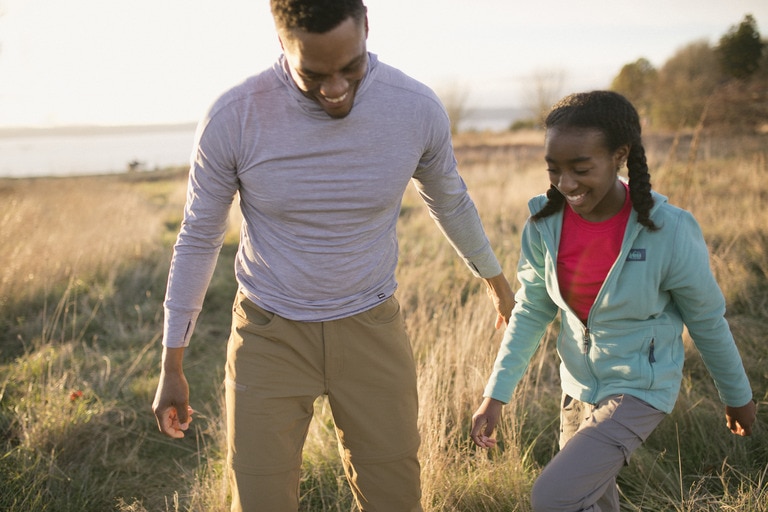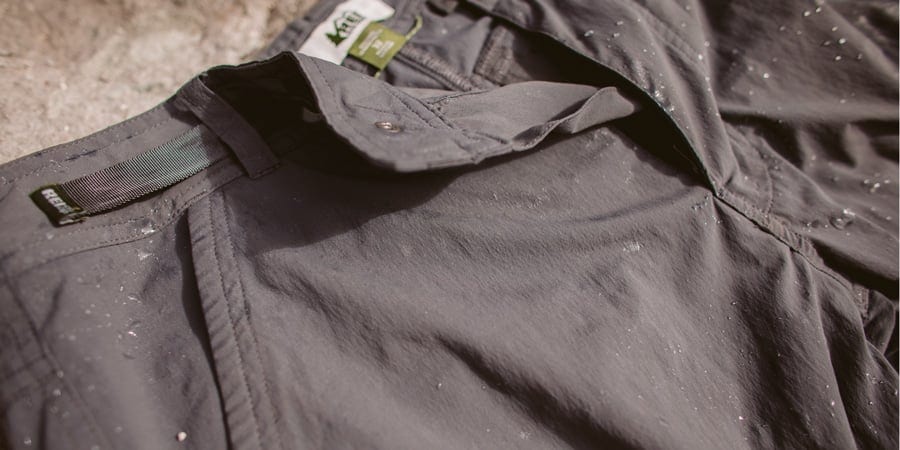One of the outdoors' greatest joys is basking in the sun's soft, warm glow. But, like so many of life's pleasures, it's best done in moderation. Sunlight includes rays of ultraviolet (UV) radiation, which can lead to sunburn, premature skin aging and skin cancer with exposure.
Choosing clothing that's designed for sun protection and tested to confirm its Ultraviolet Protection Factor (UPF) will give you greater control over your total level of UV exposure and can keep your skin safer.
This article will cover:
- Who can benefit from wearing UPF clothing (spoiler: pretty much everyone)
- What UPF ratings mean
- UPF clothing features
- Factors that reduce and enhance sun protection
If you learn nothing else about UPF, consider this: Always look for a garment's lab-tested UPF rating (if it's available) to evaluate its true UV protection level. That said, if an item doesn't have a UPF rating, there are a few things to look for when considering your options for sun protection:
- Darker fabrics usually provide more UV protection than lighter ones.
- Denser weaves provide more UV protection than looser weaves.
- Polyester and nylon offer more sun protection than natural fibers.
Shop Sun-Protective Fabric Clothing
Who Can Benefit from UPF Clothing

UPF-rated clothing enhances everyone's protection against UV-related health risks, but it is especially helpful for:
- People who are sun sensitive: People with skin that burns or freckles easily are more vulnerable to UV rays. A variety of factors can make someone more susceptible to sunburn, including skin with lighter pigmentation or a large number of moles.
- People with darker skin pigmentation: On one hand, darker pigmentation indicates the presence of more melanin, a compound that offers UV protection. But darker pigmentation also makes UV damage harder to spot—and can lull you and your doctor into being less vigilant.
- Children and older adults: Kids have relatively thin, sensitive skin, and any damage to it at an early age increases the risk of serious problems later in life. Skin damage also builds up over time, increasing the health risk for all adults as they age.
- People at high elevations, in equatorial regions, or on snow or water: UV radiation intensity is greater where the air is thinner (high elevations), where the sun is more directly overhead and UV rays have a shorter path to you through the atmosphere (equatorial regions) and where rays come both from overhead sunlight and reflected surfaces (like snow and water).
- People taking medications: Sun sensitivity is increased by a wide range of drugs, including acne treatments, antihistamines, antibiotics, certain anti-inflammatories and even herbal supplements. Double-check all your medications for cautions about the sun.
What UPF Ratings Mean
UPF is the rating system used for apparel. It's similar to SPF (Sun Protection Factor), the rating system used for sunscreen products. SPF pertains only to a sunscreen's effectiveness against UVB rays, considered to be the more damaging type of light. UPF, though, gauges a fabric's effectiveness at filtering both ultraviolet A (UVA) and ultraviolet B (UVB) light.
When you shop, things are relatively simple: Look for a higher UPF rating number and greater skin coverage in order to get better sun protection.
UPF Rating | Protection Category | Effective UV Transmission (%) |
15 | Minimum | 6.7 |
30 | Good | 3.3 |
50+ | Excellent | 2.0 |
A UPF rating of 30 indicates the fabric of a garment will allow 1/30th (roughly 3 percent) of available UV radiation to pass through it. A garment rated UPF 50 permits only 1/50th (roughly 2 percent) UV transmission. Any fabric that allows less than 2 percent UV transmission is labeled UPF 50+.
Why you don't see ratings below UPF 15: Fabrics rated below UPF 15 are not considered UV-protective. A typical white cotton T-shirt, for example, offers about a UPF 5 rating, which means that 1/5th (roughly 20%) of available UV radiation passes through it.
Factors that enhance UPF ratings: As a shopper, simply look for the UPF rating on garment hangtags or labels. Clothing makers will already have considered the following factors in trying to achieve that level of sun protection:
- Construction: Dense, tight construction minimizes the amount of UV light that can pass through. Other construction details being equal, thicker fabrics may have reduced UV transmission versus thinner ones.
- Color: Generally, darker colors prevent more rays overall (including UV rays) from reaching your skin. Within the same color, more saturated hues outperform paler ones.
- Treatments: Chemicals and dyes that are effective at absorbing UV light can be added to enhance UPF.
- Fiber type: Polyester does an excellent job at disrupting UV light, as does nylon. Wool and silk are moderately effective. Cotton, rayon, flax and hemp fabrics often score low without added treatments.
Factors that reduce the effectiveness of UPF-rated clothing: Whether you're considering the UPF spec on new clothing or packing your favorite rashguard for a trip to the beach, be aware of the following:
- Fabric wetness: For many types of materials, wetness can cause a significant reduction in a fabric's UPF rating. Some studies, though, suggest that polyester may actually protect slightly better when wet.
- Fabric wear: As a fabric becomes worn or faded, it also becomes less effective at blocking UV light.
- Fabric stretch: Stretched fabric can lose a significant amount of its UPF, so consider replacing any item that simply fits too tightly.
How laundering affects UPF ratings: Washing your clothing can either increase or decrease its UPF, depending on several factors:
- Detergents with brighteners: While most detergents contain them and most brighteners do enhance UPF, there's no way to tell for certain if a given detergent will enhance your garment's rating.
- Shrinkage: All else being equal, shrinking a garment gives it a tighter weave, which can increase its UPF.
- Clothing that relies on finishes for its UPF rating: Finishes can vary in durability. If a finish washes out, UPF diminishes. Check to see if your garment states that its UPF rating is good for a specific number of washes.
- Clothing that relies on inherent fabric properties for its UPF rating: UPF should remain relatively unchanged as a result of washing—until it diminishes simply because the fabric becomes worn or faded.
UPF Clothing Features

Here are some of the other features that UPF clothing might have.
- Extended coverage: Some shirts have flip-up sun collars; others might have cuffs that are shaped to extend coverage over the back of the hands. In hats, look for broad brims and neck capes.
- Vents: Tight weaves, thick fabrics and extended coverage also work to heat things up inside, so look for plenty of ventilation options like overlapping panels or mesh behind zippers that let air circulate without exposing too much skin.
- A looser cut: Steer clear of stretchy garments that fit too tightly, because a garment that's stretched can become significantly less effective at blocking UV light. More loosely cut rigid fabrics also increase thermal comfort through air movement.
- Quick-drying fabrics: Wetness can cause a significant reduction in a fabric's UPF rating, so having a garment that dries quickly will get you back to your full UPF rating sooner. (Packing along dry UPF-rated clothing is another strategy.)
Sun Protection Beyond UPF Clothing

Ensuring you have UPF-rated clothing is important, but total UV protection requires a multifaceted approach:
- Clothing: Wear UV-protective clothing that covers a significant amount of your skin.
- Sunscreen: Liberally apply sunscreen with a high SPF rating to all exposed areas of skin. Reapply regularly—sunscreen loses performance as time passes.
- Sunglasses: Wear ones that offer 100% UV-ray protection.
- Shade: Seek shade whenever possible, and keep in mind that water, snow and reflective surfaces can increase your UV exposure.
- Exposure time: Monitor, and limit, the amount of time you expose yourself to UV radiation, especially during peak daylight hours—roughly from 9am to 3pm.
- Sun protection isn't just for sunny days: Filtered sun can still damage your skin, so protect yourself on cloudy days, too.
Taking these precautions will keep your skin healthier. Be smart about the sun, and it will be easier to soak up the fun when you're outdoors.

